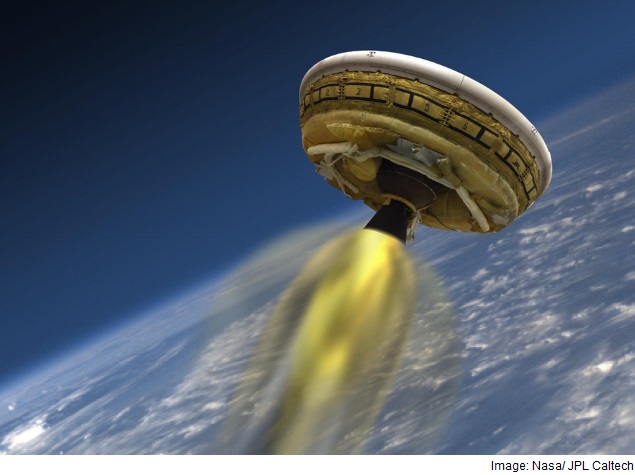- Home
- Science
- Science News
- Nasa Set for Revolutionary 'Flying Saucer' Test Flight
Nasa Set for Revolutionary 'Flying Saucer' Test Flight

If weather permits, the LDSD test vehicle will be carried aloft by a large weather balloon at 10pm IST on Tuesday from the US Navy's Pacific Missile Range Facility in Kauai, Hawaii.
For more than two hours, the balloon will carry the test vehicle to an altitude of 120,000 feet.
The tracking cameras Nasa has employed for the test are expected to keep the balloon and test vehicle in their sights for about 30 minutes after launch, the US space agency said in a statement.
After reaching a height of 180,000 feet, a doughnut-shaped airbag will inflate around the saucer for its descent to earth.
The saucer is expected to splash down in the Pacific Ocean about two hours and 15 minutes after launch.
"The test is centred on how our newly-designed supersonic parachute will perform. We think we have a great design ready for the challenge, but the proof is in the pudding and the pudding will be made live for everyone to see," said Mark Adler, project manager for LDSD at Nasa's Jet Propulsion Laboratory in Pasadena, California.
In order to support a human mission to the Red Planet, Nasa needs technologies capable of landing between 20 to 30 metric tonnes on the Martian surface.
The LDSD supports payloads of two to three tonnes, doubling the current capabilities.
During the test flight, viewers will see live, low-resolution images from high over the Pacific Ocean off the west coast of Kauai, Hawaii.
Four cameras aboard the test vehicle will provide the LDSD mission team with different perspectives on the test.
The LDSD mission will test breakthrough technologies that will enable large payloads to be safely landed on the surface of Mars, and also will allow access to more of the planet's surface by enabling landings at higher-altitude sites.
Get your daily dose of tech news, reviews, and insights, in under 80 characters on Gadgets 360 Turbo. Connect with fellow tech lovers on our Forum. Follow us on X, Facebook, WhatsApp, Threads and Google News for instant updates. Catch all the action on our YouTube channel.
Related Stories
- Samsung Galaxy Unpacked 2025
- ChatGPT
- Redmi Note 14 Pro+
- iPhone 16
- Apple Vision Pro
- Oneplus 12
- OnePlus Nord CE 3 Lite 5G
- iPhone 13
- Xiaomi 14 Pro
- Oppo Find N3
- Tecno Spark Go (2023)
- Realme V30
- Best Phones Under 25000
- Samsung Galaxy S24 Series
- Cryptocurrency
- iQoo 12
- Samsung Galaxy S24 Ultra
- Giottus
- Samsung Galaxy Z Flip 5
- Apple 'Scary Fast'
- Housefull 5
- GoPro Hero 12 Black Review
- Invincible Season 2
- JioGlass
- HD Ready TV
- Laptop Under 50000
- Smartwatch Under 10000
- Latest Mobile Phones
- Compare Phones
- Honor Win RT
- Honor Win
- Xiaomi 17 Ultra Leica Edition
- Xiaomi 17 Ultra
- Huawei Nova 15
- Huawei Nova 15 Pro
- Huawei Nova 15 Ultra
- OnePlus 15R
- Asus ProArt P16
- MacBook Pro 14-inch (M5, 2025)
- OPPO Pad Air 5
- Huawei MatePad 11.5 (2026)
- Xiaomi Watch 5
- Huawei Watch 10th Anniversary Edition
- Acerpure Nitro Z Series 100-inch QLED TV
- Samsung 43 Inch LED Ultra HD (4K) Smart TV (UA43UE81AFULXL)
- Asus ROG Ally
- Nintendo Switch Lite
- Haier 1.6 Ton 5 Star Inverter Split AC (HSU19G-MZAID5BN-INV)
- Haier 1.6 Ton 5 Star Inverter Split AC (HSU19G-MZAIM5BN-INV)
-
 New Electrochemical Method Doubles Hydrogen Output While Cutting Energy Costs
New Electrochemical Method Doubles Hydrogen Output While Cutting Energy Costs
-
 JWST Spots Most Distant Supernova Ever, From 730 Million Years After Big Bang
JWST Spots Most Distant Supernova Ever, From 730 Million Years After Big Bang
-
 ISRO Plans Third Launch Pad at Sriharikota in Four Years to Support Heavier Satellites
ISRO Plans Third Launch Pad at Sriharikota in Four Years to Support Heavier Satellites
-
 ISS Microgravity Experiment Reveal How Particles Behave Without Gravity
ISS Microgravity Experiment Reveal How Particles Behave Without Gravity











